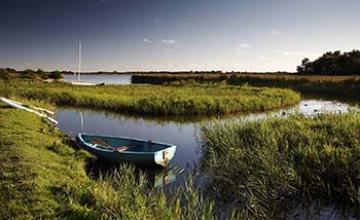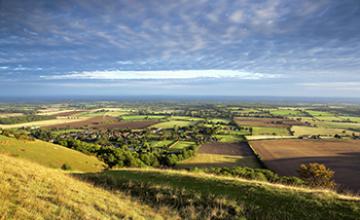
Ipswich to Cambridge
Head inland through countryside to the colleges of Cambridge
Follow the route - Ipswich to Cambridge

Ipswich to East Bergholt
> Take the A137 from Ipswich, then right on to the B1070 shortly after Brantham and finally an unclassified road via Flatford to East Bergholt.
Visiting East Bergholt
The artist John Constable was born here in 1776 and said of the area: ‘These scenes made me a painter’. Clustered round the 15th-century Church of St Mary, with its unfinished tower and remarkable bell house, are Elizabethan cottages set in beautiful gardens. Flatford Mill is now used as a Field Study Centre. Willy Lott’s Cottage, an early 18th-century mill-house which appears in Constable’s The Hay Wain, still stands beside the mill stream.
Places to stay near East Bergholt

East Bergholt to Sudbury
> Leave on the B1070 and cross the A12, turn left onto an unclassified road to pick up the B1068 for 6 ½ miles (10.6km), then right on the A134 to Sudbury.
Visiting Sudbury
Charles Dickens used this ancient cloth and market town on the River Stour as the model for ‘Eatanswill’ in The Pickwick Papers. There is a bronze statue of Thomas Gainsborough, the artist, who was born here in 1727, in an elegant Georgian town house now containing many of his paintings. The town was formerly a river port, and one of the old warehouses has been turned into the Quay Theatre. St Peter’s Church has fine painted screen panels and a splendid piece of 15th-century embroidery on velvet, the ‘Alderman’s Pall’.
Places to stay near Sudbury

Sudbury to Castle Hedingham
> Leave Sudbury on the A131, turning right on to an unclassified road after Bulmer Tye to Castle Hedingham.
Visiting Castle Hedingham
The De Vere family, Earls of Oxford, built Hedingham Castle on the hilltop in about 1140, and the banqueting hall with its minstrel gallery still survives. The keep overlooks medieval houses, which cluster round the Norman Church of St Nicholas. There are many reminders of the town’s prosperous days in the 15th-century Moot Hall and the elegant Georgian houses of the wealthy wool merchants. Just outside the village is the Colne Valley Railway, where there are restored steam engines and carriages.
Places to stay in Castle Hedingham

Castle Hedingham to Finchingfield
> Join the A1017 south for a short distance, then take unclassified roads on the right to Wethersfield, then right on to the B1053 to Finchingfield.
Visiting Finchingfield
Finchingfield’s charm has survived in spite of its great popularity. One of its many fine buildings is the gabled and barge-boarded Hill House, set opposite a row of 16th-century cottages and Georgian houses. The Church of St John the Baptist has a Norman tower and Georgian-style bell-cote.
Places to stay near Finchingfield

Finchingfield to Thaxted
> Continue on the B1053 to Great Sampford, then turn left on to the B1051 to Thaxted.
Visiting Thaxted
Thaxted’s 14th-century, cathedral-like flint church is one of the largest in Essex, with a thin, graceful spire rising 181 feet (55m). Another tall building, the tower windmill, was built in 1804, and now houses a small rural museum. The 15th-century Guildhall is built of local wood and plaster, on a foundation of flint. Composer Gustav Holst once lived in Thaxted, and Sir John Betjeman wrote of it: ‘There are few places in England to equal the beauty, compactness and juxtaposition of medieval and Georgian architecture’.
Places to stay near Thaxted

Thaxted to Saffron Walden
> Head northwest on the B184 to Saffron Walden.
Visiting Saffron Walden
Saffron Walden’s flint church rivals that of Thaxted in magnificence and size; 200 feet (61m) long and nearly as high. Its spire was added in 1831. Wool was a major industry here, but the town also prospered from growing saffron for medicine and dyes. There are delightful old narrow streets to explore, and the museum has exhibitions of furniture, ceramics and toys. Jacobean Audley End House, nearby, is in grounds landscaped by Capability Brown. Elizabeth I stayed here with the poet Sir Philip Sidney, in 1578, and the rooms have been laid out to give a ‘lived in’ feeling.
Places to stay in Saffron Walden

Saffron Walden to Duxford
> Continue on the B184 taking the A1301 at M11 junction and, in a short distance, turn left on to an unclassified road through Hinxton to Duxford.
Visiting Duxford
Duxford is a small village with a low, squat church and attractive thatched pub, the John Barleycorn. It is famous for the Imperial War Museum at Duxford Airfield, a former Battle of Britain fighter station.
Places to stay near Duxford

Duxford to Grantchester
> Cross over the A505 and continue along unclassified roads through Little Shelford to Great Shelford, then left on to the A1301 and finally left at Trumpington on to unclassified roads again to Grantchester.
Visiting Grantchester
Grantchester was immortalised in a poem by Rupert Brooke in 1912 about the Old Vicarage, where he lived. The village has a characteristic low church, with a small spire protruding.
Places to stay near Grantchester

Grantchester to Cambridge
> Head north to Cambridge.
Visiting Cambridge
Cambridge became famous as a seat of learning when the University was established early in the 13th century, and its elegant colleges and chapels of mellow stone give this beautiful city a stately air. But this is an important market centre and a leader in high technology industries, as well as a university city, and there are many fine buildings and riverside parklands. King’s College Chapel and the Bridge of Sighs are musts for all visitors, and in summer you can punt along the River Cam, which flows around the city. No visit would be complete without seeing the Fitzwilliam Museum, with its priceless collections of porcelain, antiquities, paintings and armour.



